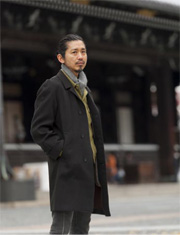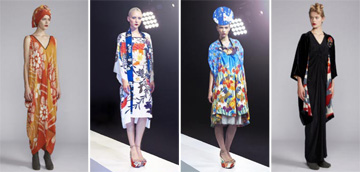Home > Highlighting JAPAN > Highlighting Japan JANUARY 2013 > Contemporary Fasion, Traditional Style
Highlighting JAPAN
[SERIES] JAPANESE ABROAD
Contemporary Fasion, Traditional Style
This month Highlighting JAPAN launches a new series, "Japanese Abroad," introducing Japanese people active in a variety of fields around the world and who have assimilated over time into the local way of life. The first in the series is Akira Isogawa, a designer hailing from Kyoto who is active in the global fashion arena from his base in Australia. His highly acclaimed Japanese-style designs are favored by celebrities such as Nicole Kidman and Cate Blanchett. Osamu Sawaji of the Japan Journal recently spoke with Isogawa.

Akira Isogawa in the grounds of Higashi Hongan-ji temple in Kyoto. Isogawa describes the atmosphere in Kyoto as one of preserving tradition while at the same time creating new things.
Credit: MASATOSHI SAKAMOTO
"I started to become interested in fashion when I was a junior high school student, buying my own clothes with the money I saved from my summer part-time job. I remember well the shock I had when I went to the Comme des Gar巽ons store in Kyoto," recalls Isogawa. "I was in my first year of high school at the time, and the displays of boldly designed clothing and the sophisticated atmosphere of the store were worlds away from everything I had known up to that point. While it seemed inaccessible, it left me wanting to find out more about that fashion."
However, at that time Isogawa did not dream of becoming a fashion designer. He went on to study at a university in Kyoto, with no fixed goal in particular. Then in 1986, at the age of twenty, a friend invited him to go to Australia under the Working Holiday scheme, transforming his life forever.
"The reason I decided to go to Australia was an interest in a world that was unknown. I had a cousin living in Australia, and whenever I read his letters I was filled with a longing for a faraway land," Isogawa explains. "When I went to Australia I had no notion of studying fashion, but I found it difficult to find clothes that I wanted to wear and I started thinking about making them for myself."

Items in Akira's 2012 Autumn/Winter collection (left and right) and (center) Akira designs being modeled during Australian Fashion Week, May 2012
Credit: COURTESY OF ISOGAWA AKIRA
However, in 1996, three years after opening the store, things changed drastically. That year, he was awarded the Australian Fashion Week Newcomer of the Year award, and gradually his designs began to be featured in magazines. Then, in 1997, Naomi Campbell wore one of his designs on the cover of the Australian edition of Vogue, and Isogawa became widely known in Australia. In 1998, he showed his designs in the Paris Collection, and in 1999 he received the Designer of the Year Award, the highest accolade in the Australian fashion industry.
Ingrained Traditions
Isogawa's fashion incorporates distinctive Japanese elements. The designs are loose-fitting and made from flowing silks or cottons, features found in traditional Japanese kimonos. Some garments are actually made from vintage kimonos bought at Kyoto flea markets. He also makes Kyoto shibori scarves as well as bags incorporating origami designs.
"My immediate and extended family valued tradition. My grandparents, who were very loving and affectionate towards me, always wore Japanese traditional clothing kimono, and the whole family used to gather at their house for traditional annual events. So the traditions of Japan and Kyoto naturally became deeply ingrained in me. The culture and history of Australia and Kyoto are totally different. That is precisely the reason that my fashion designs stood out in Australia as something new," says Isogawa. "In the future, I have no intention of chasing after commercial success or increasing the number of stores. I want to make things that I truly wish to make. For example, I am now also designing rugs, chairs, and cushions. I would like to extend my designs beyond clothing to other fields."
© 2009 Cabinet Office, Government of Japan






